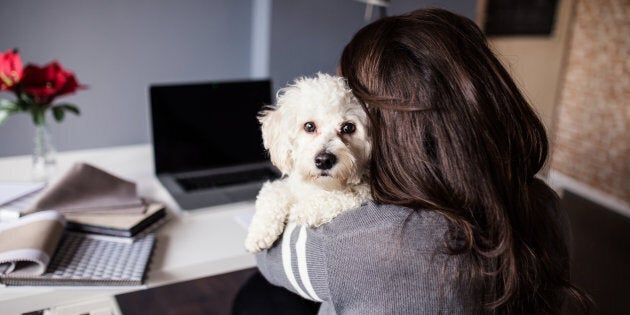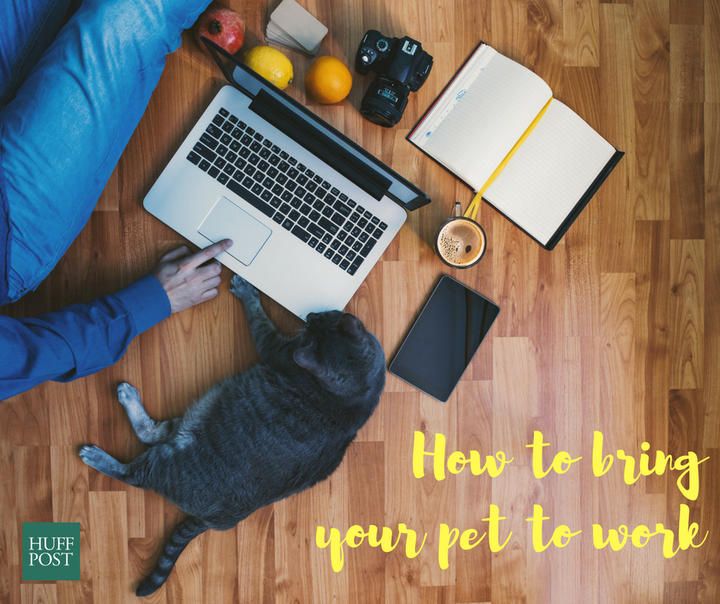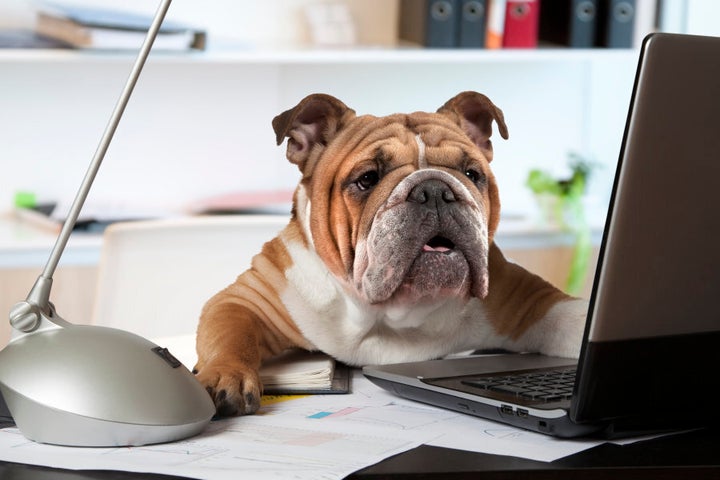
If there's one thing that would surely ease the pain of an upcoming deadline or an altercation with Susan from sales, surely it would be the friendly, fluffy face of your pet peeking out from under your desk.
While the notion of bringing your pet to work may seem fanciful to some, it's actually a trend that's on the rise in Australian offices, with companies such as Nestlé and Mars Petcare both introducing pet-friendly policies, not to mention the hundreds of businesses who get in on the action each June for Take Your Dog To Work Day or, in August, Purina's Pets At Work Day.
In fact, there's even scientific evidence that bringing your dog to work helps reduce stress levels, as well as have a positive impact on workplace morale, collaboration and productivity.
But is all this just too good to be true? Is your pet the 'right' kind of pet to take into work? And is it really just a matter of sticking them under your desk all day? The Huffington Post Australia spoke to animal behavourist Dr Jo Righetti to find out.

Do pets actually enjoy coming to work?
"A lot of pets are really attached to their owners. Dogs particularly just love to have their owners around, so the more time spent with them, the better," Righetti told HuffPost Australia.
"Cats... you know, it's on their terms. But coming to work with their owner is a real benefit to most pets, as they get to spend more time with their loved ones. If they are social beings, they get to meet lots of people and their day goes really quickly, and they are less likely to be destructive and bored at home.
"If you think about it, most people work long hours -- eight to ten hours a day -- and for the most part pets are left alone in the house during that time.
"Dogs aren't designed to be solitary animals, they are social creatures. So by the time you have been at work for a couple of hours they are looking for things to do, and that can often mean digging up the garden or some other destructive behaviour.
"In really bad cases, dogs have been known to get separation anxiety, and that kicks in the minute the owner leaves for the day."
How can I tell if my pet is 'right' for the workplace?
"Coming into the office can really can suit any pet, especially if they are already used to blending in with your lifestyle," Righetti said. "If you have the sort of pet where if, when you get up to walk, they want to walk with you, that's good. If they calm down when you calm down, that's good too.
"But for instance I have a dog who I just know if I brought into the office, the minute someone answered the phone and said 'hello?' she would start barking. She would think someone was coming to say hello. So you have to be a bit cautious in that regard. You're after animals that are outgoing and socially friendly with other people, but that can also settle down and be quiet for longish periods of time."

What are signs my pet isn't adapting to the workplace?
"If they start to really hide under your desk or refuse to come out of the carrier, that's a bad sign," Righetti said.
"With time that might improve, but if they are really not enjoying it, try to find the time to take them back home.
"If they ever start to snap at somebody or growl, then it's very important to get them out of that stressful situation. That rarely happens, I have to say. Generally you'll find dogs are wanting to meet people. They will have their heads up, be looking around, tail wagging. They may show interest in who is talking or get up, ready to meet people, when someone approaches your desk.
"Cats on the other hand may just snooze the day away on your desk. All of that is normal, healthy behaviour.
"On the other hand, barking, biting, pooing and vomiting are all negative signs to watch out for. Though regular breaks may help overcome that, it's still something to be monitored."
What to bring
"Always have a poo bag," Righetti advised. "I would say a collar and lead are essential.
"If your dog slobbers, take a slobber cloth. If your pet sheds hairs, take a roller. It's worthwhile having cleaning implements with you. Be considerate.
"Pack a bed or a blanket and, if you have a cat, a carry case. Maybe take a toy or two to keep their mouth occupied -- obviously not a squeaky one.
"See if your employer has a list of protocols and procedures and make sure you abide by those."

How to make it work
Even if your office is considering a pet-friendly policy, it doesn't necessarily mean every single employee should come to to work on Monday with a carload of animals in tow.
"You do have to be cautious, and preparation is key," Righetti said. "You do get cats that don't like dogs, and dogs that don't like cats, for instance, which could cause a bit of trouble.
"It's worthwhile nominating who should bring their pet in on what day. There has to be a bit of forced order."
For instance, pet-friendly company Mars Petcare allows a maximum of 10 dogs in the office area on any one day, and all pets must be registered before they come into the office.
"At the end of the day, though, it's a lovely thing to encourage," Righetti said. "It's nice for everyone.
"And really, most pets cope admirably. Most actually just adapt. With their owner nearby, they actually tend to settle down and just enjoy the day. It's quite beautiful to watch."
Purina 'Pets at Work' Day is held annually on 4 August. Share pics of your pet in the office using the hashtag #petsatwork.